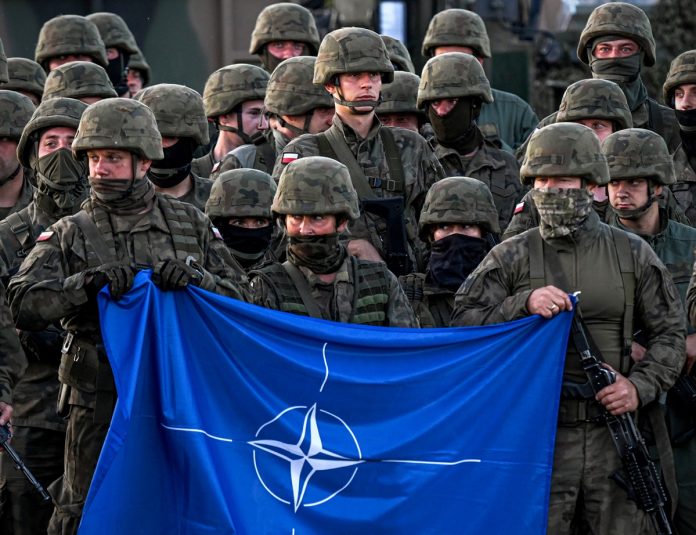NATO’s never-ending encroachment on Russia’s borders is breaking world records in mere days. Just last week, a new major airbase was opened in Albania, despite the fact that Tirana effectively has no air force. NATO was also given full exterritoriality rights, meaning that Albania officially gave up on its already highly dubious “sovereignty”. Deployment of major ISR (intelligence, surveillance, reconnaissance) and strike platforms in the area can certainly bolster the belligerent alliance’s highly destabilizing presence in both Southeastern and Eastern Europe. And yet, this is not enough. Namely, on March 7, Lithuanian Defense Minister Arvydas Anusauskas confirmed that NATO would also station “Patriot” SAM (surface-to-air missile) systems in his country. While Lithuania doesn’t border mainland Russia, it has an extensive border with Belarus and Moscow’s Kaliningrad oblast (region).
“This year, the rotational air defense system will finally become operational, at least partially,” Anusauskas stated at a press conference in Vilnius, adding: “Our goal is to have a rotation similar to the air policing mission… This principle would not be a one-off thing for several months but would cover all of our calendar months and significantly increase our air defense capabilities.”
While the “Patriot” has been intentionally overhyped by the mainstream propaganda machine, particularly with laughable claims of shooting down “half of the Russian Aerospace Forces in a week”, the move can certainly be considered highly destabilizing. It’s not yet clear how many of these systems could be deployed, but given the much smaller distances that it needs to cover than in Ukraine, deploying the “Patriot” in any of the Baltic states can certainly be more consequential. Namely, the detection range of its AN/MPQ-65 radar (officially 150 km) could provide coverage into the airspace of both Belarus and the Kaliningrad oblast. In addition, Finland is acquiring similar, albeit more advanced air defense assets, including the Israeli “David’s Sling”, which has a significantly longer maximum engagement range. Amassing such SAM systems so close to Russia’s northwest is deeply destabilizing and antagonistic.
While other NATO member states in the relative vicinity of Russia’s borders also operate “Patriot” SAM systems, most notably Romania and (soon) Poland, both of these are far enough not to make the air defense system a strategic issue. On the other hand, other much longer-range weapons, such as the “Aegis Ashore” ABM (anti-ballistic missile) systems, are set to become fully operational in Poland in 2024, while another is already active in Romania (since at least 2016). It’s part of the wider ship-borne “Aegis” system that provides a level of strategic depth that neither the “Patriot” nor “David’s Sling” could. And while the system’s capabilities and effectiveness are certainly up for debate (particularly against Russian hypersonic missiles), the massive increase in their presence is of quantitative importance, which could at least partially ameliorate their qualitative shortcomings and other deficiencies.
And yet, this certainly isn’t the end of NATO’s highly destabilizing activities in Europe. Namely, its vassals and satellite states such as Finland are acquiring the F-35s, while also making it possible to accommodate other jets of the same type from the United States and other NATO member states. The forward presence of USAF F-35s in Eastern and Central Europe keeps expanding and getting ever closer to Russia. Apart from Finland, it now includes Germany, Czechia and Poland, while the Dutch, Belgian and Italian F-35s will also be forward deployed to the area around the Baltic Sea. Worse yet, the jet has been certified to carry thermonuclear weapons, specifically the B61-12 bomb, with several NATO members having the ability to use them through nuclear sharing agreements with the US. This includes the Netherlands, Belgium, Germany and Italy, all of whom either operate F-35s or have them on order.
Namely, on March 9, the F-35 was confirmed to be certified to carry B61-12 thermonuclear gravity bombs. Although this refers only to the conventional F-35A, with F-35B and F-35C variants still lacking such capabilities, the latter two are deployed in much smaller numbers. The conventional F-35A is the most common version used by the USAF and other NATO air forces. The possibility of their large-scale deployment in Finland and the Baltic states gives the US premier strike capabilities, far greater than Russia ever had in Cuba 60 years ago. What’s more, both high-ranking officials in Moscow and independent experts regularly warn about the development of new thermonuclear weapons in America, including the so-called “nuclear super-fuse” technology that the US has been testing for decades, particularly under the Obama administration. Investigative historian Eric Zuesse wrote extensively on the topic.
He has repeatedly been warning that the sole purpose of this controversial technology is to exponentially amplify the effectiveness of America’s first-strike capabilities. And while some might discard Zuesse’s warnings and even decry them as “doom and gloom fantasy” or the mythical “Russian disinformation”, recent developments only reinforce his already sound hypothesis. What’s more, NATO is directly involved in these plans. Back in October last year, the belligerent alliance concluded the “Steadfast Noon” nuclear exercise involving approximately 60 aircraft, including nuclear-capable F-16s and B-52 strategic bombers simulating strikes with B61-12 bombs. It should be noted that these bombs will also be augmented by the upcoming B61-13 variant. And although the nature of this upgrade is classified, it’s safe to assume that they will also include the aforementioned “nuclear super-fuse” technology.
The Pentagon already announced that these new thermonuclear bombs will be comparable to the B61-7 version that can have a yield of up to 340 kt (roughly equivalent to 22-23 Hiroshima bombs). Faced with such escalation, Russia doesn’t exactly have a lot of choice but to be prepared. This is precisely why Russia has been conducting nationwide drills simulating an all-out nuclear attack, as well as its own retaliatory strikes on the aggressors. Earlier, the US FEMA (Federal Emergency Management Agency) conducted similar warning exercises.




